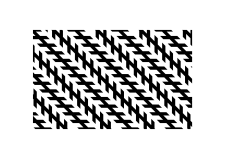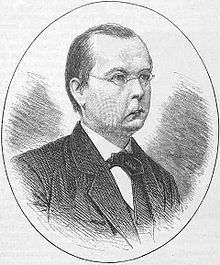Johann Karl Friedrich Zöllner
Johann Karl Friedrich Zöllner (8 November 1834, Berlin – 25 April 1882, Leipzig) was a German astrophysicist who studied optical illusions. He was also an early psychical investigator.


Biography
From 1872 he held the chair of astrophysics at Leipzig University. He wrote numerous papers on photometry and spectrum analysis in Poggendorff's Annalen and Berichte der k. sächsischen Gesellschaft der Wissenschaften, two works on celestial photometry (Grundzüge einer allgemeinen Photometrie des Himmels, Berlin, 1861, 4to, and Photometrische Untersuchungen, Leipzig, 1865, 8vo), and a curious book, Ueber die Natur der Cometen (Leipzig, 1872, 3rd ed. 1883).[1]
He discovered the Zöllner illusion where lines that are parallel appear diagonal. He also successfully proved Christian Doppler's theory on the effect of motion of the color of stars, and the resulting shift of absorption lines, via the invention of a very sensitive spectroscope which he named "Reversionspectroscope". He had shown also that the red-shift was in addition caused by variation in the stars' lights intensities with the help of his "Astrophotometer".[2]
In 1867 he made the first measurement of the Sun's apparent magnitude, using a particular "telescope / photometer" he designed. The instrument was able to superimpose two images, one from a small telescope and the second from a reference lamp. During daytime he dimmed the image of the Sun (using polarizers and diaphragms) and compared it to the lamp. During nighttime, the lamp was dimmed and compared to bright stars. He estimated the visual magnitude of the Sun to be -26.66, an extraordinary result for the time. Today's accepetd value is -26.74. This measure is very difficult, since the flux difference between the Sun and Capella (one of the bright stars he used) is roughly 50 billion times.[3]
This work was pivotal for astrophysics - leading to the discovery that star's brightness varies wildly among different stars, and also that the Sun is brighter than the vast majority of nearby stars.
The lunar crater Zöllner is named in his honor.
Spiritualism

Zöllner first became interested in spiritualism in 1875 when he visited the scientist William Crookes in England. Zöllner wanted a physical scientific explanation for the phenomena and came to the conclusion that physics of a four-dimensional space may explain spiritualism. Zöllner attempted to demonstrate that spirits are four-dimensional and set up his own séance experiments with the medium Henry Slade which involved slate-writing, tying knots on string, recovering coins from sealed boxes and the interlinking of two wooden rings.[4][5] These experiments occurred in November and December 1877 at Zöllner's home in Leipzig. He invited the scientists Wilhelm Eduard Weber, Gustav Fechner, Wilhelm Scheibner and Wilhelm Wundt to some of the sittings.[6]
The experiments were recorded by Zöllner in a book titled Transcendental Physics in 1878. According to Zöllner some of the experiments were a success.[7] However, critics have suggested that the medium Henry Slade was a fraud who performed trickery in the experiments.[8][9][10] Wilhelm Wundt who attended one of the séances, claimed that the conditions and controls were unsatisfactory. He also found the German grammatical errors on the slates suspicious as Slade was an English speaker.[6]
Slade failed the experiment regarding the interlinking of two wooden rings. Instead, it was discovered that the two rings were passed onto a table leg. This impressed Zöllner but magicians noted that such a feat is easily explainable by trick methods.[7][11]
In 1879, Hermann Ulrici brought Zollner's experiments to the attention of scientists in Germany by describing them in an academic journal. This caused a heated controversy. Wundt published a rejoinder to Ulrici, denouncing the experiments and spiritualism as non-scientific. Enraged, Zöllner attacked Wundt and threatened him with a lawsuit. Zöllner went as far as claiming that Wundt was possessed by evil spirits.[12]
George Stuart Fullerton, the secretary of the Seybert Commission, claimed that Zöllner had an "unsound mind" at the time of the experiments.[13][14]
Carl Willmann, an inventor of magical apparatus, strongly suspected that Slade had cheated. In the case of sealed slates, he suggested they could have easily been opened by a thin wire.[15]
Psychical researcher Hereward Carrington in his book The Physical Phenomena of Spiritualism (1907) revealed fraudulent methods (with diagrams of the rope tricks) that Slade may have utilized in the experiments.[16][17] Psychologist Ray Hyman has noted:
- In the case of Zöllner's investigations of Slade, not only do we know that Slade was exposed before and after his sessions with Zöllner, but also there is ample reason to raise questions about the adequacy of the investigation. Carrington (1907), Podmore (1963), and Mrs. Sidgwick (1886-87) are among a number of critics who have uncovered flaws and loopholes in Zöllner's sittings with Slade.[18]
Science writer Martin Gardner also exposed the tricks of Slade with diagrams and commented that "Zöllner did some good work in spectrum analysis, but he was supremely ignorant of conjuring methods. As a consequence he was badly taken in, I'm afraid, by Henry Slade."[19]
Publications
- Transcendental Physics (English edition, translated by Charles Massey, 1880)
References
-

- Pannekoek, Antonie. (1990). A History of Astronomy. Courier Corporation. p. 385. ISBN 978-0-486-65994-7
- [Luigi Fontana]. (2015). Stelle da Record. 3B Editore. ISBN 9-788-89565048-7
- Camp, Lyon Sprague De. (1983). The Fringe of the Unknown. Prometheus Books. p. 156. ISBN 0-87975-217-3
- Turner, J. C; Griend, P van de. (1996). History and Science of Knots. World Scientific Publishing. pp. 217-218. ISBN 978-9810224691
- Treitel, Corinna. (2004). A Science for the Soul: Occultism and the Genesis of the German Modern. The Johns Hopkins University Press. pp. 3-12. ISBN 0-8018-7812-8
- Stein, Gordon. (1996). The Encyclopedia of the Paranormal. Prometheus Books. p. 703. ISBN 1-57392-021-5 "Slade succeeded only on tests that allowed easy trickery, such as producing knots in cords that had their ends tied together and the knot sealed, putting wooden rings on a table leg, and removing coins from sealed boxes. He failed utterly on tests that did not permit deception. He was unable to reverse the spirals of snail shells. He could not link two wooden rings, one of oak, the other of alder. He could not knot an endless ring cut from a bladder, or put a piece of candle inside a closed glass bulb. He failed to change the optical handedness of tartaric dex-tro to levo. These tests would have been easy to pass if Slade 's spirit controls had been able to take an object into the fourth dimension, then return it after making the required manipulations. Such successes would have created marvelous PPOs (permanent paranormal objects), difficult for skeptics to explain. Zöllner wrote an entire book in praise of Slade. Titled Transcendental Physics (1878), it was partly translated into English in 1880 by spiritualist Charles Carleton Massey. The book is a classic of childlike gullibility by a scientist incapable of devising adequate controls for testing paranormal powers."
- Baker, Robert A. (1996). Hidden Memories: Voices and Visions from Within. Prometheus Books. p. 233. ISBN 978-1-57392-094-0 "Unfortunately, Zöllner became enraptured by the antics of the medium Dr. Henry Slade. Slade, a master prestidigitator and slate writer, was exposed by Professor Lankester as well as by Henry Sidgwick, Edmund Gurney, and W. B. Carpenter."
- Rucker, Rudolf (September 1985). The Fourth Dimension: A Guided Tour of the Higher Universes. Illustrated by David Povilaitis. Mariner Books. pp. 53–55. ISBN 978-0395393888.
- Brock, William Hodson. (2008). William Crookes (1832-1919) and the Commercialization of Science. Ashgate. p. 174. ISBN 978-0754663225
- Mulholland, John. (1938). Beware Familiar Spirits. C. Scribner's Sons. pp. 111-112. ISBN 978-1111354879
- Kohls, N; Benedikter, R. The Origins of the Modern Concept of "Neuroscience". In James J. Giordano, Bert Gordijn. (2010). Scientific and Philosophical Perspectives in Neuroethics. Cambridge University Press. pp. 44-48. ISBN 978-0-521-87855-5
- "The Slade-Zoellner Investigation". Seybert Commission.
- Jastrow, Joseph. (1889). The Psychology of Spiritualism. Popular Science. pp. 721-732
- Evans, Henry R. (1906). The Old and New Magic. The Open Court Publishing Company. p. 24
- Carrington, Hereward. (1907). The Physical Phenomena of Spiritualism. Herbert B. Turner & Co. pp. 19-47
- Carrington, Hereward. (1931). The Story of Psychic Science. Ives Washburn Publisher. p. 342. "Zöllner's experiments, however, rest under the gravest suspicion, since we know that Slade was a notorious trickster, and it is highly probable that Zöllner was duped. I have devoted a lengthy chapter in my Physical Phenomena of Spiritualism to a detailed analysis of these tests, and therein showed how they might have been due to fraud, and how they could be duplicated by such means."
- Hyman, Ray. (1989). The Elusive Quarry: A Scientific Appraisal of Psychical Research. Prometheus Books. p. 209. ISBN 0-87975-504-0
- Gardner, Martin. (1991). The Unexpected Hanging and Other Mathematical Diversions. University of Chicago Press. pp. 70-75. ISBN 0-226-28256-2
Further reading
- Hereward Carrington. (1907). The Physical Phenomena of Spiritualism. Herbert B. Turner & Co.
- Joseph Jastrow. (1901). Fact and Fable in Psychology. Macmillan and Company.
- Eleanor Mildred Sidgwick. (1886–87) Results of a Personal Investigation into the 'Physical Phenomena' of Spiritualism. With Some Critical Remarks on the Evidence for the Genuineness of Such Phenomena. Proceedings of the Society for Psychical Research 4: 45-74.
- Ulrici, Hermann. (1879). Der sogenannte Spititismus eine wissenschaftliche Frage. Zeitschrift für Philosophie und philosophische Kritik 74: 239-271.
- Wundt, Wilhelm. (1879). Spiritualism as a Scientific Question: An Open Letter to Professor Hermann Ulrici, of Halle. Popular Science 15: 577-593.